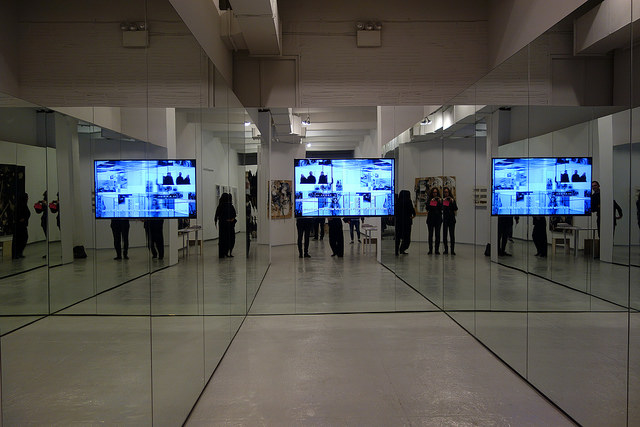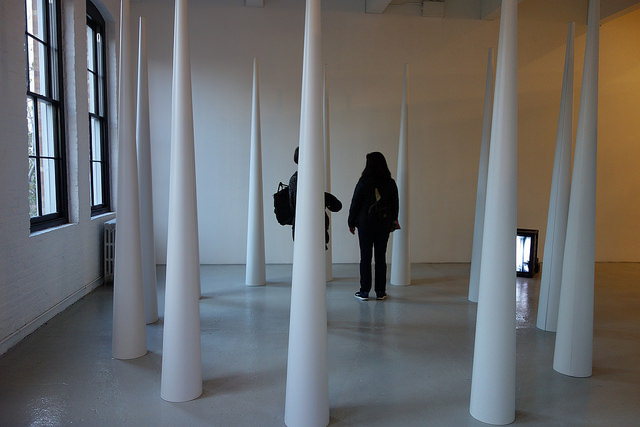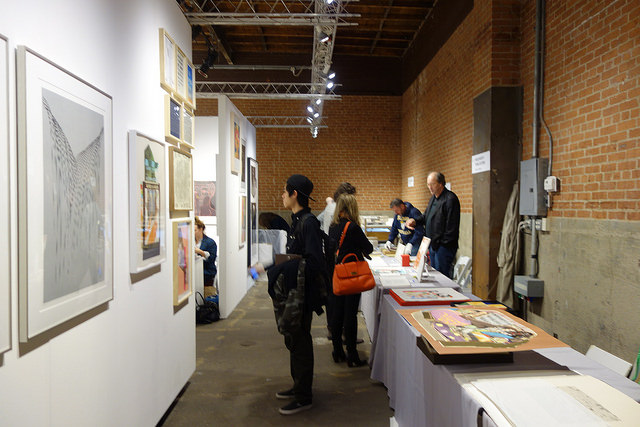It’s been a good week for art. Between the EAB Fair launch and The Independent Fair, there was more conversation to be had about the quality of art itself than the money people were paying for it. That had to do not just with the quality of work on view, but the community that created it.
This year, the Independent made its annual art fairs semi-annual, and added a weeklong show that’s open to the public. This is an enormous benefit to visitors who aren’t there to shop, but simply to look and contemplate the art itself. Of course, the first thing you notice is the preponderance of blue chip mega galleries participating—Gagosian, Venus Over Manhattan, and Metro Pictures to name just a few. That presence dies down a bit though, as you walk through the fair. Like every floor plan the Independent puts together, an open floor concept with a few floating walls divides the space, rather than the usual grid of booths.
All this is great for the public, though a two week fair may be less great for the exhibitors. Even before arriving, I’d heard some grumbling amongst dealers, that the expense of exhibiting for an additional week made the event cost prohibitive for some. In addition to larger rental fees, there are extra costs of staffing and travel to cover. Of course, anyone I spoke to at the fair had found ways to make it work. For example, Guillermo Romero Parra of Parra & Romero hired local handlers to help ship the work of Stefan Brüggemann either back to Madrid or to a collector, should it sell. He returned to Madrid Monday.
This particular piece is an enormous multi-panel canvas graffitied with the headlines from newspapers and the last lines from movies. From Ted Cruz’s story-generating statement on “Obama’s Unprecedented Attack on Israel”, to the final line that created the title for the movie I Like It Like That, we see fact and fiction blended without any distinction.
It’s not a mind-blowing work of art, and at this fair it sticks out for its size and flashiness. Unlike most art fairs, where galleries can dominate in their cube fiefdoms, the Independent’s boothless fair goes a far way in leveling the playing field so that the art can speak for itself.
And it certainly succeeds at doing that. Dominique Levy brought a box on stilts by Yves Klein that invites viewers to put their hand inside a blackened arm-sized hole in the box, only to be given a fleshy surprise. (No spoilers from us.) Nearly everyone I spoke to was talking about Liam Gillick’s film referencing Duchamp, not for the content, which no one had seen (the movie is 20 minutes long), but for the room full of mirrors it was shown in, which infinitely reflected the movie, its subtitles and the viewer.
That kind of eye candy played well here. Joan Jonas’s ring of pointy tin cones and a vintage video, Mark Barrow’s hand-painted fabric geometric abstractions and David Medalla’s “Cloud Canyons”, a white sculpture on a rotunda covered in foaming white bubbles all drew comments because, above all else, they were beautiful.
All this may seem like typical art fair fodder, but the fact is very few of these artists the art fair staples we’re tired of seeing (Anish Kapoor, Damien Hirst and John Baldessari), or make work with the fair defining materials (neon, plexiglass, and 60 foot stretchers). It’s a relief.
Given all the strong work on view, it was a little surprising to hear galleries describe the fair as “mellow”. Nearing the end of the day Sunday, I saw worried looks on many of the dealers’ faces and heard more about their “good conversations” than I did sales. Matthew Higgs told me that White Columns had done well with ceramic cats brought by 85-year-old June Hamper, but that’s hardly a surprise. Everyone in the industry knows Higgs has a great eye, and can sell anything to anyone. The cartoonish cats didn’t need his sales touch though, as they were good on their own. Standing tall and upright, as though important, they were like monuments to themselves.
As for the fair itself, Higgs had a positive take. “There’s been a nice shift in the conversation which began as about the [big] galleries in the fair and ended on the artists” he said. His comment mirrored my own experience.
One block over, the EAB art fair had similarly dropped many of the common art fair pretensions. There, I ran into artist Tony Fitzpatrick, who agreed that The Independent was better than most. “It’s not where you go to see the money fuck.” Those are the places “where everyone knows how much something costs but they they don’t know anything about the art. [The artists] are just the hired help.”
After having spent the last several years reporting on the non-existent stories that surround art fairs I couldn’t agree more. It was a relief, then, to tour the EAB in its final hours, and look at art that looked like it had a soul, and came with a price most people I know could actually afford. This is in no small part due to The Lower East Side Printshop, which had taken over the organization of the fair from Susan Inglett Gallery. The fair came with a slew of unhappy customers who felt they had been treated badly by Inglett, so they had their work cut out for them. The result, I’m happy to report was a nerdy, community driven.
Undoubtedly the biggest stand out of the fair came from Kayrock Screenprinting, which was selling Ed Ruscha-type prints emblazoning the words “Go Running Every Day” on them for $30.00. The company does great work, and artists know it—they made prints for Michael Smith, Cory Arcangel, Creative Time and more— and that Ruscha style print was just one work on a wall of similarly-priced prints they produced.
Some of the other shops showed more established artists. Dieu Donne for example, showed a James Siena, the Lower East Side Print Shop, Ryan McGinnis and Hank Willis Thomas. But even within the blue chip art making, you could see a love of the craft shine through, even if it was through something as simple as fine registration.
And of course, as I was reminded at the fair, prints are for everyone. “The best thing about prints is the democracy of it.” Fitzpatrick told me from his booth, Black Shamrock Etchings. “And this was here in spades. 51 weeks a year we’re a coven of geeks. This week we’re a community.”







Comments on this entry are closed.